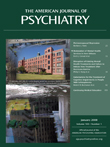Infections in the CNS During Childhood and the Risk of Subsequent Psychotic Illness: A Cohort Study of More Than One Million Swedish Subjects
Abstract
Objective: Infections during early life have been suggested to play a role in the etiology of schizophrenia. Most studies have focused on fetal life; few have explored risk associated with infection during childhood. The results of these have been inconsistent. The present study aims to investigate whether there is an increased risk of schizophrenia and other nonaffective psychoses associated with viral or bacterial CNS infections during childhood and, if so, which specific agents are involved. Method: A national cohort consisting of 1.2 million children born between 1973 and 1985 was followed up by using Swedish national registers to retrieve data on hospital admissions for CNS infections at 0–12 years of age (bacterial: N=2,435, viral: N=6,550) as well as admissions for nonaffective psychotic illnesses from the 14th birthday (N=2,269). Results: There was a slightly increased risk of nonaffective psychotic illness associated with viral CNS infections, as well as schizophrenia. There was no evidence of increased risk in relation to bacterial infections. When divided into specific agents, exposures to mumps virus or cytomegalovirus were associated with subsequent psychoses. Conclusions: Serious viral CNS infections during childhood appear to be associated with the later development of schizophrenia and nonaffective psychoses. The association with specific viruses suggests that the risk is related to infectious agents with a propensity to invade the brain parenchyma.



